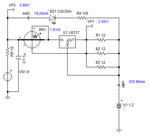T
tong
Guest

I made these circuit to temporary recharge my deep-discharged ni-mh 1.5v sanyo eneloop battery.But LM317 got very hot, can't touch. Did I wrong?
LED is red color. I use LM317 since Vref is only 1.25v then I can use the small resistor under 1W. I measured the current flow across a battery is valid ~320mA.
Last edited by a moderator:
